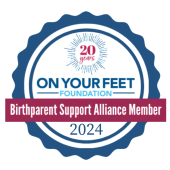
The adoption process can be complex and filled with many twists and turns. Adoptive families learn a lot along the way. For many families who choose to adopt a second time, they may feel more confident going into the process because they have more experience. However, the reality is, there is still so much to learn even when you’ve adopted before!
We recently reconnected with two families who adopted twice through ACFB. Gretchen and Mark welcomed their oldest son in 2021 and got a surprise call in late 2023 that his birth mother was about to deliver again and wanted to place her daughter with them. Although they had not been planning to adopt a second time, they knew in their hearts that they were meant to welcome her into their family.
Liz and Jon adopted their oldest son in 2018 after waiting a little over one year. A few years later, they decided it was the right time to welcome another child into their family. They started the adoption process again, but much had changed with the adoption landscape in that time. They found themselves waiting around two and half years before welcoming their youngest child in the Fall of 2023.
While both families had different experiences with their adoptions, they shared many similar details about the intricacies of adopting a second time and what they found helpful for preparing. Let’s explore the important things to know when adopting a second time.
No Two Adoptions are the Same
The Wait to Adopt
For Liz and Jon, their second match took longer to find. Thankfully, they found comfort in the fact that they had already seen how adoption can be successful. They knew that they were selected by their oldest son’s birth mother for a reason, and the same would be true for their next child. The close relationship they now have with their youngest child’s birth parents further reinforces the feeling that it was meant to be.
Gretchen and Mark had almost the opposite experience. They waited several years before welcoming their first child. Then their second adoption came when they were not even planning on adopting again. Although it was a whirlwind of excitement, fear, and uncertainty, once they met their daughter, they felt and instant bond and connection that told them this was the right plan for their family.
The Matching, Delivery, and Placement Experience
It’s easy to say each adoption is different, but what does that actually mean for adoptive families? In some cases, adoptive parents are selected and meet with the birth parents months before the due date, allowing them time to get to know each other and form a strong bond. Other times, a family may get the call that they’ve been chosen after the baby has been born, which means they are rushing to get to the hospital, meet the birth family, and wrap their heads around the fact that they are now parents all at the same time.
The hospital experience can vary drastically, too. Some birth parents prefer to share that time with the adoptive family, while others choose to spend alone time with their child before officially placing them for adoption. While adoptive families understand it is important to respect the birth parents wishes, you may find strong emotions coming up if this experience is different from your first adoption.
Adoptive families need to recognize the reality that their next match, delivery, and placement experience will be different from their first adoption. Much of this may be outside of their control, but they can prepare themselves by being open-minded to the possibilities.
Relationships with Birth Family
Even though Gretchen and Mark’s children share the same birth mother, their experience with openness was very different for each adoption. When their son was born, they spent only a few moments in the hospital with his birth mother. Although they were open to contact, his birth mother chose to keep the adoption closed. In the first few years of their son’s life, there were many moments where Gretchen and Mark wondered about his birth family and wished they could know more about them.
When their daughter was born, they got the opportunity to spend a few days in the hospital with the birth mother. They shared details of their lives and updates on their oldest son. They even got the opportunity to meet their birth grandmother. Since then, they have remained in close contact with the birth family, a connection they cherish deeply.
Liz and Jon have also experienced different relationships with openness given that their sons have different birth families. They have some contact with their oldest child’s birth family, primarily through texting. With their youngest, they have frequent communication and in-person visits. Although they are comfortable having a close relationship and contact with both children’s families, they recognize the importance of respecting the birth family’s wishes as well as setting boundaries to make the relationship successful.
Your Children May Have Different Adoption Stories
As we’ve noted, every adoption journey is different. As parents, you’ll experience this as you’re in the process of adopting, but you will also continue navigating this as your children grow up and understand their story. For Liz and Jon, this means helping their children understand why they may have more contact with one child’s birth family and not the other. There are many ways beyond openness that their story can vary, too. With two or more children, you need to be prepared to support each child’s unique needs and questions related to their own adoptions.
Now that we have established that every adoption is unique, let’s discuss how families can prepare. Whether your second adoption is planned like Liz and Jon’s, or a complete surprise like Gretchen and Mark’s, there are ways that you can prepare yourselves, your children, and your home for this big transition.
Preparing for a Second Adoption as Parents
Start Implementing Your New Routines
Anticipate Busier Lives and Strengthen Your Support System
It’s understandable that your lives become much busier when another child joins your family. Taking the time ahead to prepare can make a huge difference. Think about your daily routines and anticipate where adjustments will need to be made with a newborn. Discuss with your partner how you’ll work as a team to divide and conquer responsibilities. Identify what tasks will be challenging and don’t be afraid to lean on outside support like family, friends, and neighbors. Gretchen and Mark found that after adopting their daughter, they were much more likely to utilize the assistance that their family and friends were so eager to offer. Whether it’s occasional babysitting, cooking a meal, or even helping with your laundry, if your support system is offering, they likely want you to let them help!
Make Time for One-on-One Moments with Your Children
Preparing Your Children for a Second Adoption
Young Children
Young children may not fully understand the complexities of adoption, but there are ways to get them ready for welcoming a sibling.
Introducing the idea of another child in the family is key. Liz and Dan talked with their son about being an older brother. They would often ask if he wants a little sister or brother. He was too young to grasp the unknowns of when they would bring a child home, so they kept conversations open-ended, saying “One day…” or “When you become a big brother…” They chose to share the news that his baby brother was coming home after his birth parents signed consents.
This may be the first time your child interacts with a newborn baby. You can help spur their interest and practice “gentle” engaging by using babydolls. Liz and Gretchen both noted that this can be a great tool for helping younger children prepare.
Reading books about families adopting helps introduce the ways families can be formed. Not only does it help your child prepare for a younger sibling through adoption, but if they too are adopted, it helps them understand their own story. Some great examples are A Most Unusual Day by Sydra Mallery, We Belong Together by Todd Parr, and Some Babies are Adopted by Cindy Walker.
Older Children
While it may be easier for older children to grasp the concept of adoption, we shouldn’t assume that they may not need their parent’s support. There are ways you can help them prepare for this big change to your family.
Explain that with open adoption, it’s difficult to know exactly when and how their younger sibling will join their family. While it may not be always appropriate to share every detail of your journey, you can talk about how birth parents get to choose the adoptive family and how they may get to meet their future siblings birth parents one day.
Encourage them to talk openly about all of their feelings. We know that the adoption process can bring a whirlwind of emotions for the hopeful adoptive parents. It’s only natural that it may be emotional for your children, too. Having an environment where they can share these feelings is very important. Set aside time to check in with them and make sure to let them know that it’s normal to have all types of emotions.
There are many unknowns throughout the adoption process. Older children may be curious and ask questions you might not know the answers to. This can be a great opportunity to bond. Spend time together wondering about the possibilities. What might their future sibling look like? Will they share the same interests? What is your child most excited about when it comes to being a big brother or sister?
Transitioning Home as Growing Family
Balancing Attention from Loved Ones
Expect an Adjustment Period for Your Child
Expect an Adjustment Period for Yourself
Just like your children, it’s normal for you to experience an adjustment period, too! Even if you’ve been anticipating this adoption for a long time, it is still a massive change that can bring all kinds of emotions. Gretchen shared that for their first adoption, it took her two weeks to get out of the shock phase. After their second adoption, which was a complete surprise, it took a month to get out of the shock phase and another four months to feel completely adjusted and settled as a family. It’s only natural that you may feel overwhelmed, frazzled, and even in disbelief. It’s also understandable if you feel sadness as you let go of your life as a parent to just one child. Treat yourself with grace and empathy during this time.
Adopting for a second time may feel daunting in ways your first adoption did not. While you’re more familiar with the adoption process and experienced when it comes to parenting, you are also anticipating changes to your life as parent, your family dynamics, and a whole new adoption experience. Our hope is that with this guide and ACFB’s support, you feel well-prepared for the journey ahead.
If you are considering adopting again and want support through the process, visit Adoption Center for Family Building or contact us here. We are here to guide you each step of the way as you grow your family.





